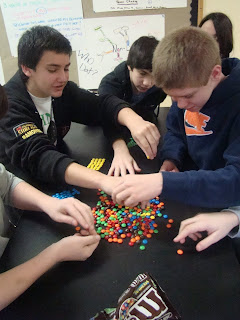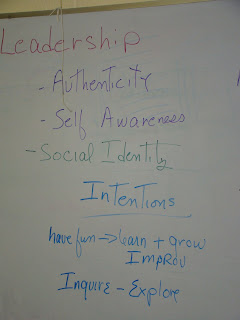



Today's program was taught by Dr. David Altman, Vice President of Research and Development at the Center for Creative Leadership in Greensboro. Dave opened the session with a "self-awareness test" where students were asked to count basketball passes they saw on a video clip. The class was astonished that each child missed the moon-walking bear in the video, and so the message was that "it's easy to miss something you are not looking for" came across very clearly.
Dave asked students to rate their leadership capability now and in the future. A greater percentage of the class gave themselves high ratings for leadership in future years. Several activities followed, where the kids chose cards and described positive and negative examples of effective leadership ideas. Zippy said that a "top dog" took what he should share. Noah chose "not my problem," explaining that leaders have to take responsibility for their actions.
"When you think about being a leader...which quote speaks to you?" was Dave's next question, as he herded the eighth graders to a table full of pithy quotations about leadership.
Haddas said, "You need to know what you're doing, not just think about it," explaining why she chose her quote.
Sydney added, "You have to learn about things; you're not just born with leadership."
Zippy noted, "To be a good leader, you have to have an adventurous side and a serious side."
Celia spoke carefully, "When you do something you enjoy with people you enjoy, you're a more effective leader."
Eli pondered, and said, "Everybody has a path; you just have to follow it."
Sergey: If you are what you do best, and if you are good, so be it. If you are not very good, do not strive to be what you are not."
Noah commented, "I always feel like I'm in tune, go out there and do what I'm going to do - so don't waste a day."
After photographs, metaphors and quotes, Dave introduced a new fragrance test, asking students to pick one candle and reflect on insight it evokes. "How does it relate to leadership?" he asked the students.
Haddas thought her smell prompted peacefulness, calm and uniqueness. Sydney talked about calm and being openminded. Comfortable, homelike and relaxing, were sense Zippy felt from her scented candle. "Strong yet calm" was Celia's description. "You reap what you sow," was Eli's comment on leadership - emanating from a fruit scent. "I implement what I know to describe this smell - a normal rainy day." said Sergey. "You have to be confident to be a leader," said Noah. "It smells like nature," said Maxx.
"Write a six word short story," said Dave, citing the six word short story by Ernest Hemingway: "For sale. Baby shoes. Never worn." He asked students to base the short story on the metaphors, quotes and pictures they collected, thinking about a leadership philosophy. A selection of the "short stories" appears below.
Sergey's story: There is no going back now.
Celia: Be strong,yet careful. No giving up.
Zippy: Be a good leader, you'll help.
Sydney: Helping hands are how to succeed.
Eli: First prove, then achieve, finally inspire.
Noah: To be a leader, must grow.
Final words from Maxx - which neatly sum up the session: "Trees can sprout through land uncultivated."











































